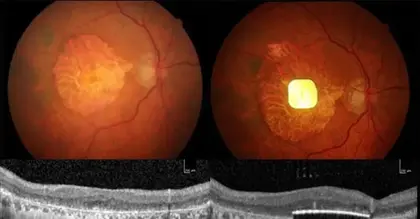Note: This document contains side effect information about methoxsalen. Some dosage forms listed on this page may not apply to the brand name Oxsoralen-Ultra.
Applies to methoxsalen: oral capsule liquid filled. Other dosage forms:
- injection solution
Warning
Oral route (Capsule)
Methoxsalen with UV radiation should be used only by physicians who have special competence in diagnosis and treatment of psoriasis and who have special training and experience in photochemotherapy. Photochemotherapy should be restricted to patients with severe, recalcitrant, disabling psoriasis which is not adequately responsive to other forms of therapy. Risks of therapy include ocular damage, aging of the skin, and skin cancer (including melanoma). The soft gelatin capsules should not be used interchangeably with regular methoxsalen capsules or hard gelatin capsules due to greater bioavailability and earlier photosensitization onset time. Patients should be treated in accordance with the dosimetry specifically recommended for this product. The minimum phototoxic dose (MPD) and phototoxic peak time after drug administration prior to onset of photochemotherapy with this dosage form should be determined
Serious side effects of Oxsoralen-Ultra
Along with its needed effects, methoxsalen (the active ingredient contained in Oxsoralen-Ultra) may cause some unwanted effects. Although not all of these side effects may occur, if they do occur they may need medical attention.
Check with your doctor immediately if any of the following side effects occur while taking methoxsalen:
- Blistering and peeling of skin
- reddened, sore skin
- swelling (especially of feet or lower legs)
Other side effects of Oxsoralen-Ultra
Some side effects of methoxsalen may occur that usually do not need medical attention. These side effects may go away during treatment as your body adjusts to the medicine. Also, your health care professional may be able to tell you about ways to prevent or reduce some of these side effects.
Check with your health care professional if any of the following side effects continue or are bothersome or if you have any questions about them:
More common
- Itching of skin
- nausea
Less common
- Dizziness
- headache
- mental depression
- nervousness
- trouble in sleeping
Treatment with this medicine usually causes a slight reddening of your skin 24 to 48 hours after the treatment. This is an expected effect and is no cause for concern. However, check with your doctor right away if your skin becomes sore and red or blistered.
There is an increased risk of developing skin cancer after use of methoxsalen. You should check your body regularly and show your doctor any skin sores that do not heal, new skin growths, and skin growths that have changed in the way they look or feel.
Premature aging of the skin may occur as a result of prolonged methoxsalen therapy. This effect is permanent and is similar to what happens when a person sunbathes for long periods of time.
For Healthcare Professionals
Applies to methoxsalen: compounding powder, injectable solution, oral capsule.
General
The most common adverse event was nausea, which may be minimized or avoided by taking the medication with milk or food, or dividing the dose into 2 portions taken approximately 30 minutes apart.[Ref]
Dermatologic
Very common (10% or more): Pruritus (10%)
Frequency not reported: Erythema, hypopigmentation, vesiculation and bullae formation, non-specific rash, herpes simplex, miliaria, urticaria, folliculitis, cutaneous tenderness, extension of psoriasis
Postmarketing reports: Rash[Ref]
-Pruritus can often be alleviated by frequent application of bland emollients or other topical agents.
-Severe pruritus may require systemic treatment. If pruritus is unresponsive to these measures, shield pruritic areas from further UVA exposure until it resolves.
-Discontinue treatment until pruritus resolution for intractable generalized pruritus.
Erythema:
-Mild, transient erythema at 24 to 48 hours after PUVA therapy is expected and indicates a therapeutic reaction.
-Any area showing moderate (grade 2 or higher) erythema should be shielded during subsequent UVA exposure until the erythema has resolved.
-Grade 2 or higher erythema that appears within 24 hours after treatment may signal a potentially severe burn.
-Erythema may progressively worsen over the next 24 hours, since peak erythemal reaction characteristically occurs 48 hours or later after methoxsalen ingestion.
-Monitor the patient closely and protect from further UVA and sunlight exposures.
Differences between PUVA erythema and sunburn or UVB phototherapy:
-The percent transmission through skin of UVS varies from 0 to 34%, where UVA varies from 1 to 80% (UVA is transmitted through a larger percentage of the skin)
-PUVA induced DNA lesions may lead to a DNA crosslink, which is more lethal and psoralen-DNA photoproducts may be unfamiliar substrates for DNA repair enzymes.
-DNA synthesis is suppressed longer after PUVA.
-The time course of delayed erythema with PUVA is different and may not involve the usual mediators seen in sunburn; PUVA-induced redness may be just beginning at 24 hours (UVB erythema is past its peak by this time).
-Histological alterations from PUVA show more dermal vessel damage and longer duration of epidermal and dermal abnormalities.[Ref]
Cardiovascular
Common (1% to 10%): Hypotension
Frequency not reported: Arrhythmia[Ref]
Gastrointestinal
Very common (10% or more): Nausea (10%)
Common (1% to 10%): Vomiting
Frequency not reported: Gastrointestinal disturbances
Postmarketing reports: Dysgeusia[Ref]
Immunologic
Common (1% to 10%): Infection/catheter related infection/ sepsis
Frequency not reported: Folliculitis[Ref]
Psychiatric
Frequency not reported: Nervousness, insomnia, depression[Ref]
Hypersensitivity
Postmarketing reports: Allergic reaction[Ref]
Local
Common (1% to 10%): Vascular access complication[Ref]
Other
Common (1% to 10%): Transient fever
Frequency not reported: Edema, malaise
Postmarketing reports: Pyrexia[Ref]
Nervous system
Frequency not reported: Dizziness, headache[Ref]
Musculoskeletal
Frequency not reported: Leg cramps[Ref]




